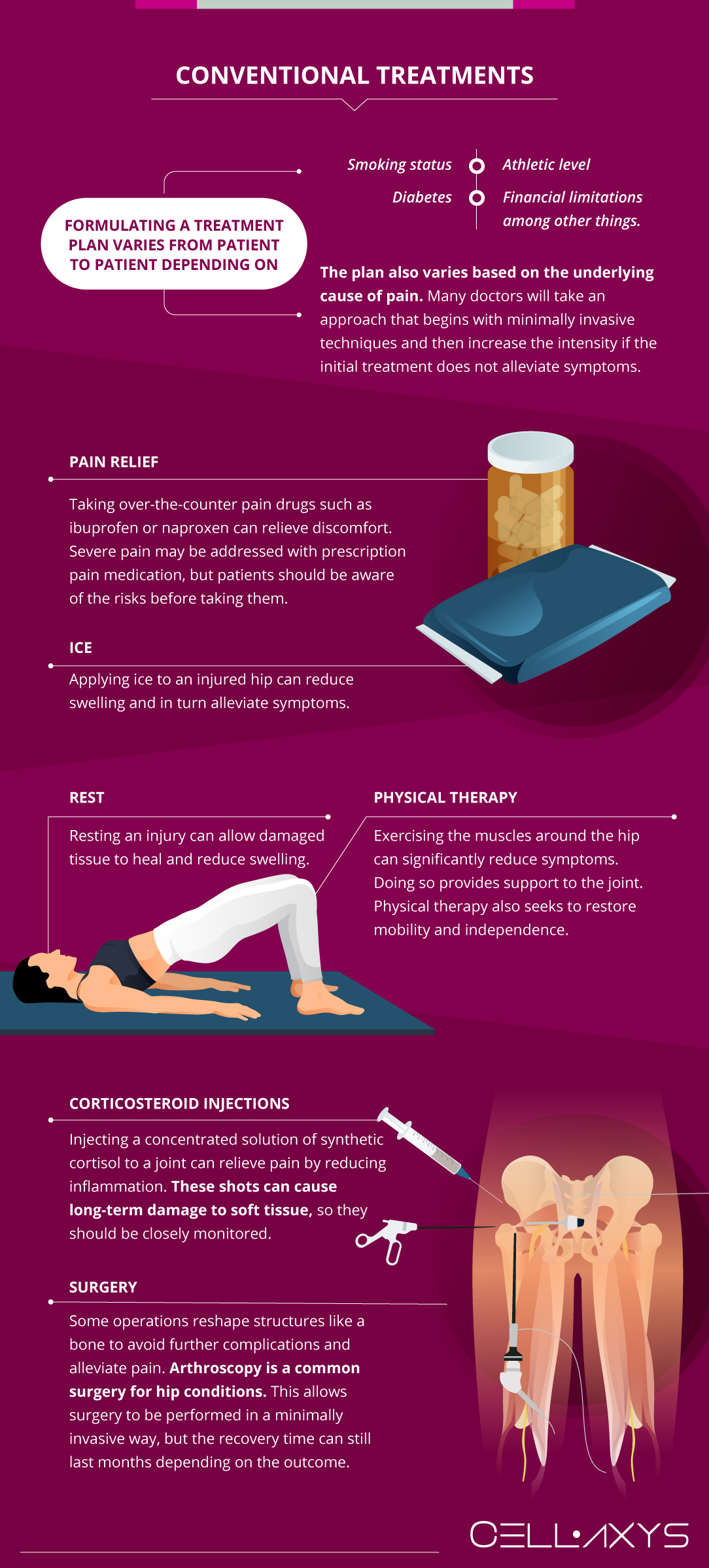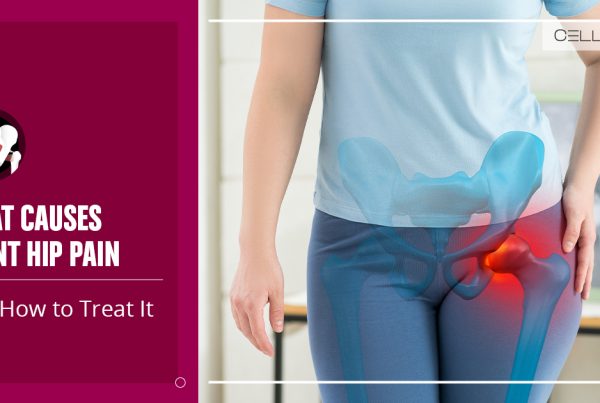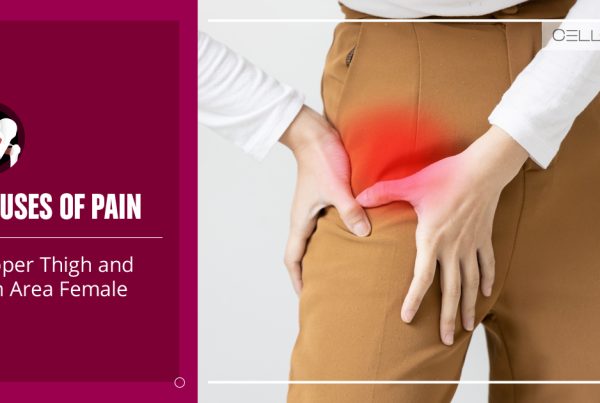Published on: February 24, 2020 | Updated on: August 29, 2024
Hip pain can range from mildly inconvenient to completely debilitating. It often occurs gradually, however, so it’s possible to address the issue before the pain becomes unbearable.
Many conventional treatments for hip pain can alleviate symptoms but fail to address the underlying cause. After trying several treatment options with no relief many turn to total hip replacement surgery in an attempt to find relief. Though surgery may seem like the only option, there are alternative treatments worth looking into.
Causes of Hip Pain and Diagnosis
Due to its frequent use, the hip joint can be prone to injuries. Pain often occurs when parts of the joint become misaligned or displaced. Previous injury, misuse, and frequent use can all contribute to hip problems later in life.
The hip is a ball-and-socket joint, where the head of the femur (thigh bone) fits into a pocket in the pelvis called the acetabulum. Articular cartilage exists between the two bones to prevent them from rubbing against one another, which can cause pain and long-term damage. This cartilage also allows the joint to glide smoothly, allowing for a wide range of motion.
Activities such as running, sitting, and lifting can all contribute to hip pain, among many others. Certain professions that involve heavy use of the hips may result in long-term damage. Another common cause of hip pain is a previous traumatic injury such as a car accident or fall. Long-term damage can also occur due to deformities in the bones or muscles which may be genetic or a result of years of misuse.
Once the pain becomes unmanageable or begins to interfere with daily life, consult a medical professional. Many conditions may be causing hip pain. The diagnosis process often involves a physical examination, gathering personal and medical information, and diagnostic tests. Some of these tests may include an MRI, X-ray, or CT scan, for example.
Treatment begins once a diagnosis has been made. Patients may need to undergo more than one diagnostic test to determine the root cause of symptoms.
Conventional Treatments

Formulating a treatment plan varies from patient to patient. Some factors that may influence the treatment of hip pain include smoking status, diabetes, athletic level, and financial limitations among other things.
The plan also varies based on the underlying cause of pain. Many doctors will take an approach that begins with minimally invasive techniques and then increase the intensity if the initial treatment does not alleviate symptoms. Some of these treatments include:
- Pain relief: taking over-the-counter pain drugs such as ibuprofen or naproxen can relieve discomfort. Severe pain may be addressed with prescription pain medication, but patients should be aware of the risks before taking them.
- Ice: applying ice to an injured hip can reduce swelling and in turn alleviate symptoms.
- Rest: resting an injury can allow damaged tissue to heal and reduce swelling.
- Physical therapy: exercising the muscles around the hip can significantly reduce symptoms. Doing so provides support to the joint. Physical therapy also seeks to restore mobility and independence.
- Corticosteroid injections: injecting a concentrated solution of synthetic cortisol into a joint can relieve pain by reducing inflammation. These shots can cause long-term damage to soft tissue, so they should be closely monitored.
- Surgery: many different surgeries may alleviate symptoms without resorting to a total hip replacement. Some operations reshape structures like bone to avoid further complications and alleviate pain. Arthroscopy is a common surgery for hip conditions. Using only a small incision, surgeons insert a tiny camera and tools into the injury site. This allows surgery to be performed in a minimally invasive way, but the recovery time can still last months depending on the outcome.
Patients often undergo these treatments or others before even considering a total hip replacement. However, when conventional treatment fails to relieve symptoms, patients should consider alternative options.
Cell-Based Therapies; Using your own Stem Cells or other healing Cells as a treatment option.
The practice of regenerative orthopedic medicine has gained traction recently as a means of treating injuries and arthritis as well as preventing future injuries from occurring. The concept of these treatments is to take a patient’s own cells which contain healing properties, concentrate them, and transplant them back into the hip causing pain. At CELLAXYS, we focus on procedures using your own body’s natural healing cells. The two most popular and requested procedures are:
- Autologous Stem Cell Transplant: Stem cells are the building blocks of the body. Stem cells, specifically “MSCs,” are obtained from two tissues in the body for procedural purposes, fat and bone marrow. These tissues are harvested and then concentrated in order to prepare them for transplantation. The concentrated tissues and stem cells are then transplanted under live X-Ray in order to improve pain and function. These procedures typically have long-lasting effects on your pain.
- Platelet-Rich Plasma (PRP) Therapy: platelets are cells that the body uses to form blood clots and heal damage. They are the ‘first line of defense’ in most injuries in the body. There have 10 different growth factors and proteins that ‘call out’ to other cells and send them to the troubling location as well as creating a potent anti-inflammatory response. The anti-inflammatory response is created by a protein called “Interleukin 1 Receptor Antagonist.”
Both procedures begin with taking a sample of the cells or blood. As mentioned above, autologous stem cells are extracted from bone marrow or adipose (fat) tissue. The cells are then concentrated and activated, then returned to the patient in the form of an image guided transplant. Our Fellowship Trained physicians have performed thousands of procedures ensuring your optimal outcome.
Autologous Stem Cell Transplants are performed under anesthesia in order for your comfort and fast recovery. These procedures typically take about 2 hours to complete.
PRP therapy begins with a simple blood draw. The blood sample is then placed in a centrifuge to separate the platelets from other components in the blood. Once the platelets are more concentrated, they are transplanted into the problem area. Similar to stem cell therapy, doctors use imaging technology to determine the location of the injection.
These both are outpatient procedures.
Results may become apparent in a matter of days and sometimes as quickly as a couple of hours. Treatments sometimes involve more than one injection over time – this will be determined during a preliminary medical evaluation.
Benefits of Regenerative Therapy
Regenerative medicine is unique as a treatment in many ways. Cell-based therapies, including, autologous stem cell transplants, offer real benefits for patients who are suffering from pain and meet the criteria for the procedure.
Sources
Footnotes
- Ferguson RJ, Palmer AJ, Taylor A, Porter ML, Malchau H, Glyn-Jones S. Hip replacement. The Lancet. 2018;392(10158):1662-71.
- Dawson J, Fitzpatrick R, Murray D, Carr A. Comparison of measures to assess outcomes in total hip replacement surgery. BMJ Quality & Safety. 1996;5(2):81-8.
- Patel V, Vlassakov K, Janfaza DR. Total hip replacement. Anesthesiology: Clinical Case Reviews. 2017:341-6.
- Li M, Sun W, Zhou R, Huang Y, Meng F, Luo L, Yan Z, Shi X, Huang F, Fan C, Jiang Z. Non-pharmaceutical treatments to relieve pain or reduce opioid analgesic intake and improve quality of life after total hip replacement: a meta analysis. American Journal of Translational Research. 2022;14(10):6828.
- Berge DJ, Dolin SJ, Williams AC, Harman R. Pre-operative and post-operative effect of a pain management programme prior to total hip replacement: a randomized controlled trial. Pain. 2004;110(1-2):33-9.
References
- The Hip Joint. TeachMe Anatomy. Accessed 2/23/2024.
- Alternatives to Hip Replacement. Verywell Health. Accessed 2/23/2024.
- Doctors Find Alternative to Total Hip Replacement. AARP. Accessed 2/23/2024.
- A regenerative alternative to hip replacement. Mayo Clinic. Accessed 2/23/2024.
- Cortisone shots. Mayo Clinic. Accessed 2/23/2024.
- Arthroscopy. Mayo Clinic. Accessed 2/23/2024.
CELLAXYS does not offer Stem Cell Therapy as a cure for any medical condition. No statements or treatments presented by Cellaxys have been evaluated or approved by the Food and Drug Administration (FDA). This site contains no medical advice. All statements and opinions are provided for educational and informational purposes only.
Dr Pouya Mohajer
Author
Pouya Mohajer, M.D. is the Director of Spine and Interventional Medicine for CELLAXYS: Age, Regenerative, and Interventional Medicine Centers. He has over 20 years of experience in pain management, perioperative medicine, and anesthesiology. Dr. Mohajer founded and is the Medical Director of Southern Nevada Pain Specialists and PRIMMED Clinics. He has dedicated his career to surgical innovation and scientific advancement. More about the doctor on this page.
Dr Pejman Bady
Contributor
Dr. Pejman Bady began his career over 20 years ago in Family/Emergency Medicine, working in fast-paced emergency departments in Nevada and Kansas. He has served the people of Las Vegas as a physician for over two decades. Throughout this time, he has been met with much acclaim and is now the head of Emergency Medical Services in Nye County, Nevada. More about the doctor on this page.









